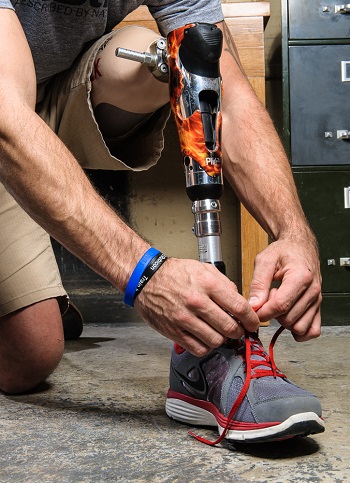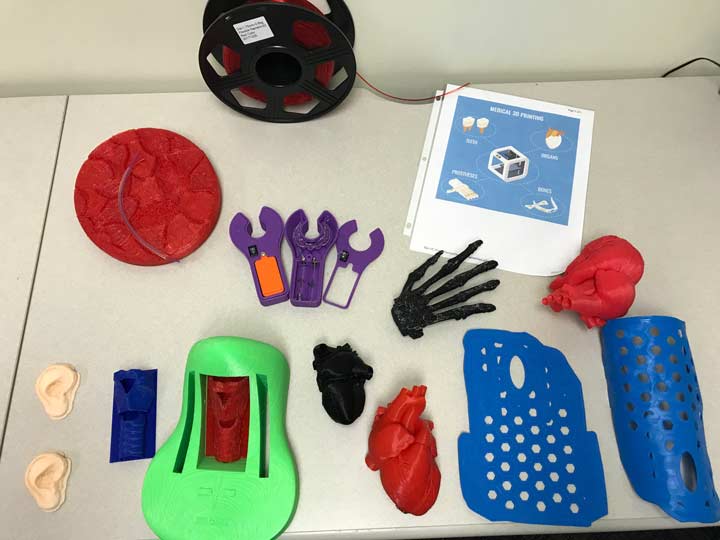3-D printing
See the following -
$250 Million to Support Advanced Robotics Venture Led by CMU
 An independent institute founded by Carnegie Mellon University will receive more than $250 million to launch an advanced robotics manufacturing institute in Pittsburgh, the U.S. Department of Defense announced Friday. The Department of Defense awarded the public-private Manufacturing USA institute to American Robotics, a nonprofit venture led by Carnegie Mellon, with more than 220 partners in industry, academia, government and the nonprofit sector nationwide. The institute will receive $80 million from the DOD, and an additional $173 million from the partner organizations. The Richard King Mellon Foundation played a particularly important role in catalyzing the CMU proposal...
An independent institute founded by Carnegie Mellon University will receive more than $250 million to launch an advanced robotics manufacturing institute in Pittsburgh, the U.S. Department of Defense announced Friday. The Department of Defense awarded the public-private Manufacturing USA institute to American Robotics, a nonprofit venture led by Carnegie Mellon, with more than 220 partners in industry, academia, government and the nonprofit sector nationwide. The institute will receive $80 million from the DOD, and an additional $173 million from the partner organizations. The Richard King Mellon Foundation played a particularly important role in catalyzing the CMU proposal...
- Login to post comments
3-D Printing a Better Prosthetic
 In 1981, Ian Gregson popped into the prosthetics shop in a Vancouver hospital to buy a new leg. The shopkeeper took various measurements, then made a plaster cast of the amputee’s residual limb to craft an attachment. Prosthetic limbs, particularly the sockets that hold them on, must be carefully fitted to an amputee. Now, a stunt man in the film industry and a two-time competitor at the Paralympic Games, for shot put and discus throw, Gregson describes his current socket-maker as an artist, a master who passes his skills on to a few select protégés...
In 1981, Ian Gregson popped into the prosthetics shop in a Vancouver hospital to buy a new leg. The shopkeeper took various measurements, then made a plaster cast of the amputee’s residual limb to craft an attachment. Prosthetic limbs, particularly the sockets that hold them on, must be carefully fitted to an amputee. Now, a stunt man in the film industry and a two-time competitor at the Paralympic Games, for shot put and discus throw, Gregson describes his current socket-maker as an artist, a master who passes his skills on to a few select protégés...
- Login to post comments
3-D Printing Offers Quick, Cost-effective Solution to Help Train Aspiring Nurses
 As a regular attendee of conferences on healthcare simulation around the world, Dr. Lori Lioce was already well aware of the growing trend of using 3-D printing to create task trainers – clinical simulators that allow nursing students to repeatedly practice a specific skill in preparation for providing healthcare in the real world. What she needed was access to the technology. So the clinical associate professor in the College of Nursing at The University of Alabama in Huntsville (UAH) turned to Norven Goddard, a research scientist at UAH’s Systems Management and Production (SMAP) Center, for help.
As a regular attendee of conferences on healthcare simulation around the world, Dr. Lori Lioce was already well aware of the growing trend of using 3-D printing to create task trainers – clinical simulators that allow nursing students to repeatedly practice a specific skill in preparation for providing healthcare in the real world. What she needed was access to the technology. So the clinical associate professor in the College of Nursing at The University of Alabama in Huntsville (UAH) turned to Norven Goddard, a research scientist at UAH’s Systems Management and Production (SMAP) Center, for help.
- Login to post comments
3-D Printing Turns Nanomachines into Life-Size Workers
 Nanomachines are tiny molecules – more than 10,000 lined up side by side would be narrower than the diameter of a human hair – that can move when they receive an external stimulus. They can already deliver medication within a body and serve as computer memories at the microscopic level. But as machines go, they haven’t been able to do much physical work – until now. My lab has used nano-sized building blocks to design a smart material that can perform work at a macroscopic scale, visible to the eye. A 3-D-printed lattice cube made out of polymer can lift 15 times its own weight – the equivalent of a human being lifting a car...
Nanomachines are tiny molecules – more than 10,000 lined up side by side would be narrower than the diameter of a human hair – that can move when they receive an external stimulus. They can already deliver medication within a body and serve as computer memories at the microscopic level. But as machines go, they haven’t been able to do much physical work – until now. My lab has used nano-sized building blocks to design a smart material that can perform work at a macroscopic scale, visible to the eye. A 3-D-printed lattice cube made out of polymer can lift 15 times its own weight – the equivalent of a human being lifting a car...
- Login to post comments
Print No Evil: Three-Layer Technique Helps Secure Additive Manufacturing
 Additive manufacturing, also known as 3-D printing, is replacing conventional fabrication processes in critical areas ranging from aerospace components to medical implants. But because the process relies on software to control the 3-D printer, additive manufacturing could become a target for malicious attacks – as well as for unscrupulous operators who may cut corners. Researchers from the Georgia Institute of Technology and Rutgers University have developed a three-layer system to verify that components produced using additive manufacturing have not been compromised...
Additive manufacturing, also known as 3-D printing, is replacing conventional fabrication processes in critical areas ranging from aerospace components to medical implants. But because the process relies on software to control the 3-D printer, additive manufacturing could become a target for malicious attacks – as well as for unscrupulous operators who may cut corners. Researchers from the Georgia Institute of Technology and Rutgers University have developed a three-layer system to verify that components produced using additive manufacturing have not been compromised...
- Login to post comments
Tübingen neuroscientists develop inexpensive, self-manufactured lab equipment
 Laboratory equipment is one of the largest cost factors in neuroscience. However, many experiments can be performed with good results using self-assembled setups with 3-D printed components and self-programmed electronics. The inexpensive system called “FlyPi” developed by André Maia Chagas and Tom Baden allows for many standard lab processes including light and fluorescence microscopy, optogenetics, thermogenetics, and behavioural studies in small animals (e.g. round-worms, fruit flies, zebrafish larvae)...
Laboratory equipment is one of the largest cost factors in neuroscience. However, many experiments can be performed with good results using self-assembled setups with 3-D printed components and self-programmed electronics. The inexpensive system called “FlyPi” developed by André Maia Chagas and Tom Baden allows for many standard lab processes including light and fluorescence microscopy, optogenetics, thermogenetics, and behavioural studies in small animals (e.g. round-worms, fruit flies, zebrafish larvae)...
- Login to post comments